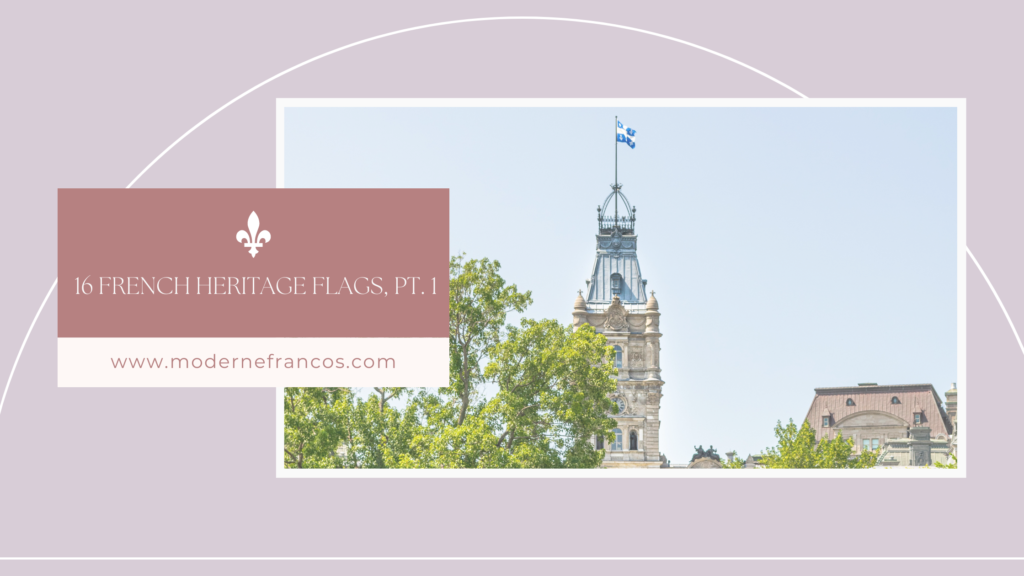
There are 16 Flags for French-Heritage People in North America: Which One Represents You?
When you think of French-speaking people in North America, you may think exclusively of Quebec in Canada. However, many communities of French-Canadians throughout Canada speak French fluently. In the United States, descendants of French-Canadian immigrants are also recognized.
With so many people of French descent in North America, groups and organizations have come together to keep their culture alive and discover long-lost cousins across borders!
Altogether, there are 16 flags to discuss among Québécois & French-Canadians, Acadians, and Franco-Americans.
Check out Part 1 below! Links have been added for some of the flags and I will update this post if I find links for the remaining flags.
Disclosure: Some of the links below are affiliate links. This means that, at zero cost to you, I will earn an affiliate commission if you click through the link and finalize a purchase.
The Flag of Québec

There are 8 million people represented by the flag of Québec, which depicts the following:
- The white symbolizes purity.
- Four white fleurs-de-lis in every corner.
- A blue background with white stripes running vertically and horizontally.
- The blue symbolizes heaven, inspired by a banner honoring the Virgin Mary.
The flag of Québec represents the inhabitants of New France and present-day Québec. It was the first provincial flag that Canada officially adopted. It was displayed on January 21, 1948, at the Parliament Building in Quebec City.
Québec’s flag day is none other than January 21 to annually commemorate its adoption.
Some French-heritage residents of Québec describe themselves as Québécois rather than French-Canadian.
Québécois and French-Canadians are the descendants of the French settlers who arrived in New France in 1608. It’s the only North American region with a French-speaking majority, including one of only two provinces in Canada where French is recognized as an official language. (New Brunswick is the other of these two provinces).
The term Québécois came about during the Quiet Revolution of the 1960s. These Québécois previously referred to themselves as French-Canadian but chose a more unique name to represent their heritage and culture.
So what does it mean to be Québécois? According to the definition, a Québécois is a native or inhabitant of Quebec whose first language is French.
Our next group is French-Canadians, described as inhabitants of Canada who speak French. French-Canadians can also trace their lineage back to the settlers of New France but do not have to reside in Quebec.
There are nine other flags associated with French-Canadians, so let’s go through them one by one:
The Franco-Albertan flag
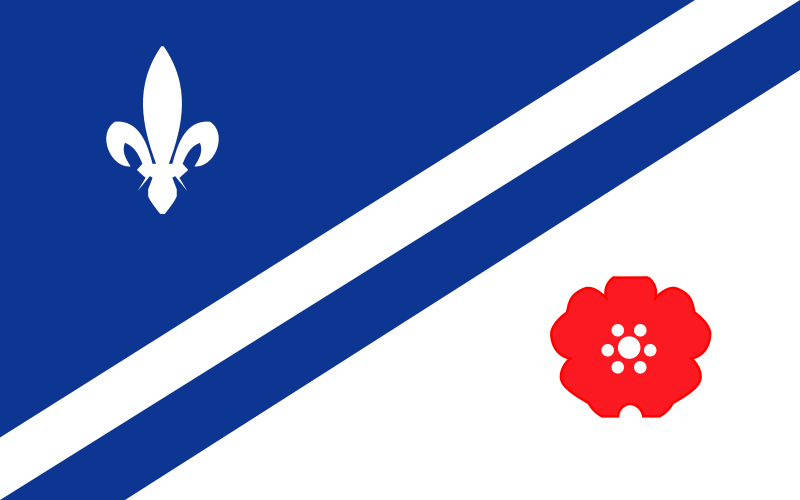
This flag is a representation of French-Canadians in the province of Alberta.
The flag was adopted in 1982 and is symbolized with colors and French symbols:
- The fleur-de-lis symbolizes French culture.
- The wild rose and the color blue represent Alberta.
- The color white is for the Francophone community.
- The blue and white bands represent the waterways and routes used by French explorers and early settlers.
The Franco-Albertans are described as residents who speak French as a first language.
In the 2016 Canadian Census, 86,705 Albertans stated that their mother tongue was French. There were also 411,315 Albertans in that same census who claimed partial or full French ancestry.
The Franco-Columbian Flag

This flag represents French-Canadians in British Columbia.
The flag was adopted in 1982 and features the floral emblem of British Columbia: the Pacific dogwood tree, which was adopted as the symbol in 1956.
This flag also features the following:
- The blue lines represent the sea.
- Likewise, the raised lines represent The Rocky Mountains.
- The stylized Fleur-de-lis stands for the Francophone community.
- The dogwood flower petals around a yellow circle, symbolizing the sun.
The majority of Franco-Columbians speak English and French. In the 2016 Canadian Census, 71,705 British-Columbians cited French as their first language.
What are the Franco-Columbians best known for?
The first Francophones in British Columbia were French-Canadian voyageurs employed with the North West Company during the 18th and 19th centuries. French fur traders were present in the region in the early 19th century.
The largest Franco-Columbian community in British Columbia is Maillardville, a neighborhood within the city of Coquitlam. Maillardville originated from French-Canadian lumber workers who worked for the Canadian Western Lumber Company from Eastern Ontario and Québec in 1909.
Present-day Maillardville is described as “a community with a Francophone heart” due to its Francophone community organizations, schools, churches, retirement home, and scouts group. Maillardville also hosts Festival du Bois, an annual celebration of Francophone culture.
The Franco-Manitoban Flag
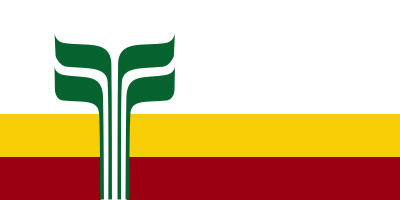
This flag represents French-Canadians in the province of Manitoba.
The flag was unveiled in 1980 with a stylized “F” for Francophone reflected on both sides to create the shape of a green plant. According to the 2016 Canadian census, about 40,900 residents of Manitoba stated that French is their first spoken language.
Also featured on the flag are:
- A red band that symbolizes the Red River.
- A yellow band for the wheat fields in Manitoba, something the province is known for.
During the late 17th century, the first French settlers in the region were fur traders. A significant historical event in this province was the Red River Rebellion, led by Louis Riel.
Riel was a Métis leader who, along with his followers at the Red River Colony, began the early establishment of a provisional government in 1869.
Francophones were the majority of the province up until the mid-19th century, when Anglophones became the linguistic majority.
The Franco-Yukonnais Flag

This flag represents the Yukon Territory of Canada, where the French language has official language status.
According to the Canadian 2016 Census, there are 1,575 Francophone residents in the Yukon Territory, which is 4.4% of the Yukon’s total population. The territory’s population also has about 3,500 to 4,000 residents of partial French descent, which is 13% of the total population.
The Franco-Yukonnais flag was registered on August 15, 2018, in the Canadian Heraldic Authority’s Public Register of Arms, Flags, and Badges of Canada. The flag is light blue with three diagonal stripes ⎯ two white and one golden yellow ⎯ in the center.
Here are the details of this flag:
- The blue stands for French heritage people and the Yukon sky.
- The white stripes represent the winter season and the snow it brings.
- The shape of the diagonal stripes represents the Yukon’s many mountain ranges.
- The golden yellow stripe represents the Klondike Gold Rush and the historical contributions of the Franco-Yukonnais community to the territory.
The Association Franco-Yukonnaise is the primary institution of the Franco-Yukonnais community. A non-profit organization, it organizes cultural activities and serves as a voice for the Francophone community in Yukon. This territory is also known for the bi-weekly newspaper, L’Aurore boréale.
The Franco-Nunavut Flag

This flag represents Franco-Nunavois in Nunavut, where French is a second or third language for the small population. However, Francophones are rising in this location, from 465 to 616 between 2006-2016.
Most Franco-Nunavois live in the capital, Iqaluit. This cultural group settled recently, with only 13% of the territory’s Francophones being Franco-Nunavois by birth. In the 19th century, many groups arrived in Nunavut, like whaling crews, Missionary Oblates, and then French-Canadians, to cooperatively break the commercial monopoly of Hudson’s Bay Company in the Inuit towns.
The flag design features:
- A dual blue and white background represents the Arctic sky and the heavy snow of the region.
- The stone structure, called an inuksuk or inukshuk, symbolizes the human footprint of this remote territory.
- The dandelion, a flower known for its strength and adaptability to its environment, stands for the resilience of the Franco-Nunavois population.
The Franco-Nunavut flag was adopted in 1981 but wasn’t flown until 2002. That same year, the child care center called Les Petits Nanooks was founded by the Association des francophones du Nunavut (AFN). The Société immobilière Franco-Nunavut and the Conseil de coopération du Nunavut were founded in 2007.
Nunavut was a part of the Northwest Territories (NWT) until 1999. The federal government oversaw the NWT, but English was the only official language of public affairs.
In 1984, the city of Yellowknife adopted the Official Languages Act, which made English, French, Inuktitut, and either other Indigenous languages the official languages of the NWT.
The Franco-Nunavois are known for organizing a family snowmobile rally every spring and the Partie d’huîtres every fall to celebrate the local culture.
The Franco-Tenois Flag
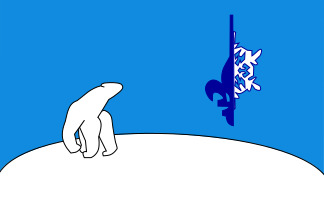
This flag was adopted in 1992 and represents the Franco-Tenois in the Northwest Territories. According to the 2006 census, only 440 residents of the NWT, which is about 1.1% of the population, speak French at home.
In recent years, figures show that the Francophone population is increasingly staying in the NWT. However, the trend of outward migration continues to occur, with Francophones settling from other parts of Canada and then moving away.
This flag’s design features:
- The blue sky represents la Francophonie.
- The curved base represents the NWT location above the 60th parallel near the North Pole.
- A dark blue fleur-de-lis and snowflake symbolize the Francophone community in the North.
- A polar bear on a white, curved base. Polar bears represent freedom and nature in the vast North.
Francophones have a long history in the NWT, with the first person of European descent to reach the region being Laurent Leroux, a fur trader, businessman, and political figure.
When the NWT was under the jurisdiction of the Canadian government, 47% of the non-native population spoke French. French took precedence in the region from commerce to education until 1892, when French was abolished as an official language in the NWT.
However, in 1984, French as an official language was restored in the Canadian territories. In 1988, a network of local organizations was created in the NWT to unite isolated areas of the Francophone settlement. The Fédération franco-ténoise is the leading representative organization of the Franco-Tenois community.
The French language is one of 11 official languages in the NWT, alongside English, Chipewyan, Cree, Gwich’in, Inuinnaqtun, Inuktitut, Inuvialuktun, North Slavey, South Slavey, and Tlicho.
The Franco-Newfoundlander Flag

This flag represents the Franco-Newfoundlanders, also known as the Franco-Terreneuvians, of Newfoundland and Labrador. The name derives from Terre-Neuve, the French word for Newfoundland.
The Franco-Newfoundlanders are primarily associated with the Port au Port area in communities like Trois-Cailloux, Cap-Saint-Georges, La Grand’Terre, L’Anse-aux-Canards, and Maisons-d’Hiver.
This flag’s design features:
- The sails also represent action and progress.
- The yellow sails are the same shade as the star on the Acadian flag.
- The spruce twig is the emblem of Labrador, also found on the flag of Labrador.
- A blue, white, and red tricolor inspired by France’s tricolor and the Acadian flag.
- Two yellow sails ⎯ one with a spruce twig and the other with a pitcher flower ⎯ symbolize the early Basque, Breton, and French fishermen that arrived in the region in 1504.
Other Francophone communities are found in St. John’s, Labrador City, and Happy Valley-Goose Bay.
Newfoundland is distinct, being the only area in the province officially designated by provincial law as a bilingual district. The region’s culture is a mix of Québec, Acadia, Brittany, Basque Country, and St. Pierre and Miquelon influences.
There are more flags that represent the various French-Canadian communities of Canada, so stay tuned for Part 2 of this post!
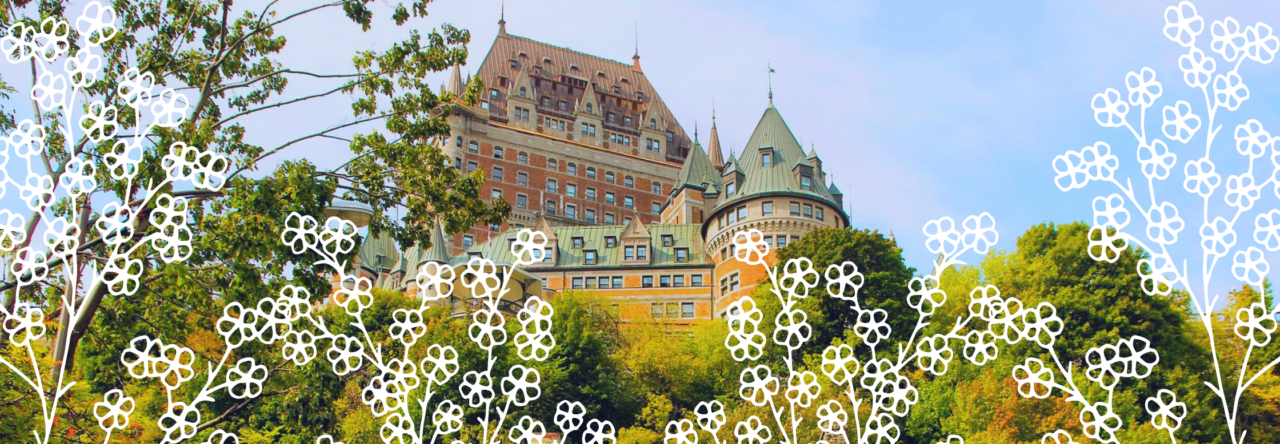
Leave a Reply